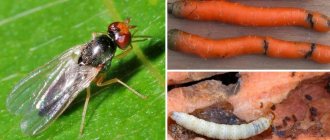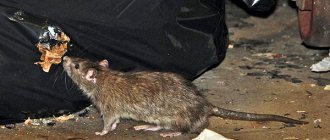Earth rat: description
The ground rat is common in summer cottages and vegetable gardens; its external description can be imagined as follows - an animal with a massive body and a large head, a blunt muzzle. The vole's tail is sometimes longer than the body, round in cross-section and covered with small hairs.
Characteristics of the earth rat:
- Body length with tail is from 16 to 22 cm.
- Tail length – up to 13 cm.
- Maximum weight – 380 g.
The nature of the ground rat's fur changes depending on the time of year.
In summer it consists of sparse and short hairs, in winter - of thick and long ones. This allows the animal to control heat exchange. The intensity of reproduction and the number of cubs depend on external conditions. In the southern regions of the country, where there is a comfortable air temperature all year round, a female can bear offspring more than 3 times. In other areas, the breeding process occurs a maximum of three times, lasting from early spring to late autumn. The older the female, the more cubs she brings in one litter. To care for their offspring, adults build a nest underground, where the young live until they reach 30 days of age. After this, the cubs are able to survive on their own.
The ground rat does not hibernate; it leads an active lifestyle throughout the year. Most of the time she hides underground and prefers to go out in search of food in the dark for a short period. The animal prefers to consume aboveground and underground parts of plants as food.
Folk remedies
Folk remedies are less effective, but they are simple and do not require financial costs, which is why they are popular among people.
A pungent smell can quite realistically scare away rodents and force them to leave not only the garden, but the house or apartment. Such “odors” include the smell of a burnt rabbit skin or a burnt car tire placed in a hole. Pests also cannot tolerate the smell of wormwood or mint, which is more pleasant to humans. Planted at the dacha, such plants will protect the area.
If you need to free an open area of land, such as a vegetable garden, from rats, you can try flooding the holes with water. Despite its simplicity, you are guaranteed to get rid of rats, especially if the flooding is repeated.
You can also recall such a feature of rodents as intolerance to noise. How to create it is up to everyone to decide for themselves, depending on their preferences. Some people regularly play loud music if their dacha neighbors allow it, while others hang empty cans or rustling cellophane in the garden. The result will be equally effective.
Since the animals are excellent at climbing trees, you can dig around them so that a small ditch is formed, and pour water into it along with peat crumbs mixed with kerosene.
What does a ground rat look like?
There are many rodent pests found in the country. In order to choose the right strategy to combat them, you should determine what type of animal is spoiling your beds and plants. To do this, you need to know what an earth rat looks like:
- short fingers with long claws;
- hind legs extended;
- on the back there is dark brown fur with different shades;
- on the belly there is dirty white fur.
Rare representatives of earth rats have a completely black coat. Animals can be distinguished from moles by their small underground passages. In addition, unlike blind rodents, this type of vole mouse does not hibernate during the winter. The ground rat differs from the gray rat in having a short tail without scales and a softer coat.
Chemical methods of control
Chemicals should be used as a last resort when others have failed. The most successful would be to use:
- Special poison for mice and fill each hole with it or sprinkle it before entering it. It is important at this time to remove children and pets away from the area where chemicals are used or choose another method of control;
- Gas bombs. They are suitable only at the very beginning of the shrew’s settlement, since over time it appears more and more tunnels, and it can hide in the opposite area;
- Diesel oil and gasoline. They are poured into the hole, but this method only helps at the very beginning of the appearance of the shrew.
All these methods are suitable for combating shrews, but they should be used away from fruit trees, vegetables, fruits and berries and it is better to give preference to repellers that will repel animals from the area without harming them.
Habitat of the ground rat
The ground rat is found in almost all parts of Russia, except for the Far North. It is most common in European regions, Siberia and the Caucasus. In favorable external conditions and with a sufficient food supply, the number of rodents per hectare of field can reach 400 individuals.
The habitat and age of the earth rat influences the nature of the coat. The animal is able to swim and dive well. Individuals of this species prefer to inhabit places with high humidity and move to summer cottages when open bodies of water freeze or there is a flood. Finding themselves in places with a sufficient food supply, they set up nests here and populate barns and other buildings. Migration to fields and vegetable gardens may also be associated with a sharp increase in population size.
You can detect the presence of a rat on the site by small flat piles of earth in the garden bed. They are formed when an animal forms passages inside the soil at a depth of up to 15 cm. A rodent’s nest is a complex and intricate network of passages, several chambers with food reserves and a nesting compartment.
Earth rat: control measures
The earth rat, making passages at a depth of 10-15 cm, eats everything it encounters along the way. She is not averse to tasting rice, alfalfa, grains and melons, and cotton. When the number of animals reaches critical levels, productivity decreases and many plants die.
The ground rat loves to eat the bark and roots of young trees - willow, bird cherry, apple tree. This is a predatory animal that is ready to eat insects, field mice, mollusks and crayfish. Once in residential premises, earth rats without hesitation destroy food supplies and feed.
How to protect your home and property from pest invasion? The ground rat is a representative of rodents, and control measures will be similar. They are divided into several categories - mechanical, chemical, folk and professional.
Mechanical traps against earth rats
If earth rats have appeared on your summer cottage relatively recently, you can get rid of them using mechanical traps. Installing special devices is advisable only when we are talking about single individuals. They must be regularly checked and freed from captured animals. Glue devices will not help in the fight against rats. The animal, thanks to its large body, can easily free itself from such a trap. It is better to use a mousetrap or a special rat trap.
Use of pesticides
Chemicals are the most effective way to kill rodents yourself. When using them, you should strictly follow the manufacturer’s instructions, prevent pets from coming into contact with the toxic substance, and carry out the treatment with gloves and a mask. Improper use of pesticides can cause serious harm to human health, cats and dogs.
Anti-rodent medications can be purchased at the store in the form of powder, granules and liquid. Key uses:
- adding to water, milk and other liquids;
- creating baits from attractive products with the addition of a toxic substance;
- scattering powder and granules near burrows and in places where rodents may appear.
Pesticides can rid your home and garden of a large population of earth rats. But this will require patience and several treatments.
Traditional methods against earth rats
Almost all folk methods are aimed not at destroying, but at repelling rodents. Most of them are based on the use of pungent odors and odorous plants. Poisonous elderberry and wild rosemary release cyanides and alkaloids into the air and soil. The keen sense of smell of the ground rat senses danger from afar, and the animal prefers to avoid such territory.
Other methods of repelling earth rats:
- Grow juniper and other conifers on the site, the needles of which damage the animal’s paws.
- Singe pieces of wool or fur, place them near holes and in places where rodents are most likely to appear. The strong smell will scare away animals.
- Mix Vishnevsky ointment with water and treat the floor covering in the room with the resulting solution. A pungent odor will force rodents to leave the area.
- The paws of the ground rat are not protected by fur. Ash scattered over the area can cause inflammation.
- Install ultrasonic repellers. The devices emit waves that are safe for humans, but cause anxiety in rodents. The animals are in a hurry to leave such a place. Ultrasonic repellers can be installed around the perimeter of the site or indoors.
Traditional methods are optimally suited for organizing a protective barrier and will help prevent the reappearance of rodents in the summer cottage and in the house. The method is not suitable for exterminating earth rats, which have already managed to occupy the territory and have increased the population to critical sizes.
Professional measures to combat rats
A sharp decrease in yield, numerous damage to the root system and ground shoots of cultivated plants is one of the evidence of a large number of rodents in a summer cottage. In such a situation, it is better to immediately seek help from a professional SES, since it will be very difficult to cope on your own. If radical measures are not taken, earth rats will continue to multiply and settle in the barn, cellar and house, and begin to destroy food supplies.
Employees are ready to help in the fight against rodents. Certified chemicals and a fog generator are used to process objects. The device sprays the active substance in the form of fine dust, the particles of which penetrate into holes, crevices and all hard-to-reach places. SES workers will also give recommendations on how to prevent the reappearance of earth rats in your summer cottage and in your house. For consultation, contact the manager of “Des Group” by phone.
How to drive out a field rat
As with any pest, it is better to prevent uninvited guests from appearing. There are several ways to do this.
- Animals. Rats do not settle in areas where there are cats and dogs. Of course, this applies to those pets that are active outside. An indoor cat won't help here.
- Ultrasonic repellers. They cost some money, but are effective. The sound is inaudible to humans, but repels rats, mice and moles. There are different models that differ in range and type of power supply.
- Unpleasant odors. Rodents have a very delicate sense of smell, so unpleasant odors prevent them from living on the site. They won't drive out a large colony, but they will definitely drive out a few animals from the barn.
A proven remedy is Vishnevsky ointment. Of course, it is noticeably unpleasant for the human sense of smell, but for the sake of business you can tolerate it.
- Direct contact. The paws of the ground rat are very sensitive. Spruce needles, glass wool, and broken glass scattered around the perimeter of the site will be a good obstacle. Wood ash on the skin causes wounds, so it can also be used. Moreover, it is also a good fertilizer.
- Hunters. And this does not mean shooting earth rats. Dogs, especially several hunting breeds and cats, when they see a rodent, will immediately turn on their instincts and strangle it or simply drive it out. Often this type of rodent is also called earthdog.
- Physical contact – traps such as mousetraps, rat traps or glue traps. The first ones work effectively, but they need to be constantly checked. But there is also a risk that pets may get caught in the trap. Sticky strips are not very effective on a large animal.
- Chemicals. This method is effective and efficient, but requires caution. It is best to place poisons in burrows and underground passages so that the insect is sure to swallow it. However, there are a number of significant disadvantages. The poison can also be ingested by cats or dogs. But there is another important point - chemicals remain in the soil for a long time and can get into plants.
How to get rid of rats in a barn
Rats in the barn scare the animals and steal eggs. You need to get rid of them quickly, but at the same time take care of the safety of other residents.
How to get rid of rats on your property
Rats on the site spoil crops, bulbs, roots and gnaw the bark or shoots of young trees. They must be removed quickly, without delay.











